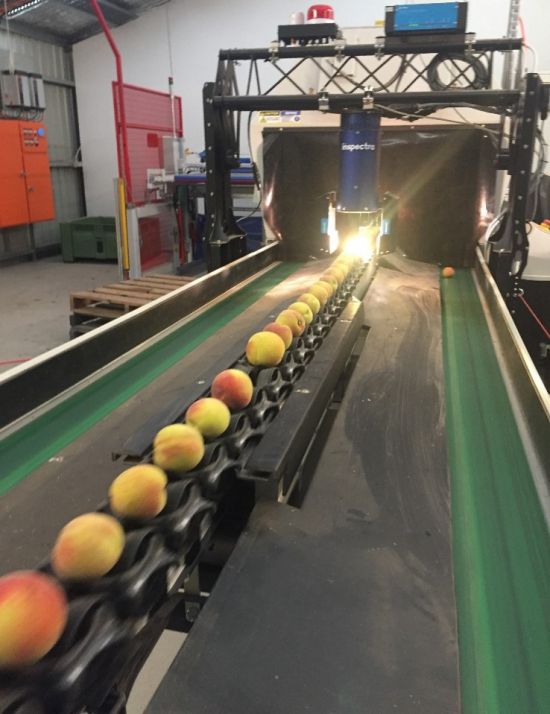Ag-Tech sensors and machine learning are used to measure and sort fruit on a grading line (300 – 500 fruit/min per grading lane).
In the fruit analytics laboratory at the Tatura SmartFarm, AVR horticultural researchers have utilised grading technology equipped with visual and NIR imaging systems to measure external (skin colour, sunburn, russet) and internal (flesh sweetness, firmness, maturity) fruit quality parameters of every single piece of fruit picked from novel field experiments.

Consumers demand uniform, blemish free, high colour and good taste experiences of apple, pear, peach, nectarine, plum and apricots. Nowadays, fruit sorting technology of commercial grading systems in packhouses enables growers to supply fruit to market specification.
This technology has provided the basis for accelerated agronomic production packages and thus creating new orchard management practices for improved horticulture industry outcomes.
About this Research Harvest facility
Video: Dr Mark O'Connell discusses the Harvest Facility at Tatura SMartFarm (Agriculture Victoria) with a commercial fruit grader equipped with sensors for scientific analysis.
Video transcript - Harvest facility
I'm Mark O'Connell from agriculture Victoria and welcome to the harvest facility here at Tatura. What I'm standing in front of today is a fruit grader, a sorting grader. It's a commercial grader, and it's equipped with a number of sensors to help us measure and understand fruit quality, both internal and external features of the fruit. And what we're really interested in is capturing the data of individual fruit to examine our experimental results from the field. We have a range of field experiments on stone fruit and pears at the research station here at Tatura. And, a lot of experimental plots and measurements are required to understand those experimental treatments. They include agronomic management like root stocks, crop load (the amount of fruit we put on trees), irrigation management, training systems etc..
So, I'll give you a quick run through of some of the features of this grader. It's yet to be fully commissioned but basically the design is that it can individually weigh fruit, measure size and diameter. And, in this box here there's a couple of sensors. There's a visual camera system and an infra-red camera system that basically lets us measure the external features, the skin features of the fruit including colour and blemish, limb rub, russet type features for example. As we go down the line, we have another sensor called the NIR which basically measures internal attributes of the fruit, that could be sweetness and some other maturity indices, and/or water core in apple, for example. And then we go into the next sensor, where there is a load cell here that weighs individual fruit. And obviously, with the smart software, you collect that individual fruit data and then you get to petition and sort that fruit into those groups of quality and size or colour that you decide. So that's pretty well the basic layout of the machine.
Behind us, behind the machine we have two new cool rooms, which we'll be able to obviously store large amounts of fruit once the harvests come in from the field. And behind that facility we have two C A rooms where we will have set up shortly, some chambers to examine different atmospheres e.g. for post-harvest transport, shipping etc.. or aircraft type, airfreight type protocols.
Acknowledgement
This research (SF12003 Increased stone fruit profitability by consistently meeting market expectations; SF17006 Summerfruit Orchard Phase 2) was funded by Agriculture Victoria with co-investment from Horticulture Innovation Australia Limited using the Summerfruit levy and funds from the Australian Government.
This publication may be of assistance to you, but the State of Victoria and its employees do not guarantee that the publication is without flaw of any kind or is wholly appropriate for your particular purposes and therefore disclaims all liability for any error, loss or other consequence which may arise from you relying on any information in this publication. While every effort has been made to ensure the currency, accuracy or completeness of the content we endeavour to keep the content relevant and up to date and reserve the right to make changes as require. The Victorian Government, authors and presenters do not accept any liability to any person the information (or the use of the information) which is provided or referred to in the report.